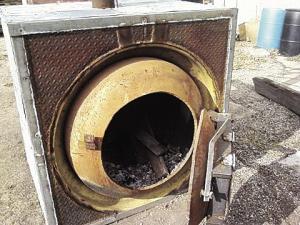2011 - Volume #35, Issue #6, Page #25
[ Sample Stories From This Issue | List of All Stories In This Issue | Print this story
| Read this issue]
Outdoor Wood Stove Built With Combine Wheels
 |
 |
 |
Over the past 15 years, Luschen has made about a dozen “combine” stoves for friends, family and neighbors using wheels, auger tubing and other scrap parts. The forced air outdoor stoves burn wood. Old furnace blowers circulate heat.
Luschen prefers to use big beveled Deere wheels that create cones on each end when two of them are welded together.
He makes a 22-in. door for easy loading on one end of the stove and a draft on the other end.
In the back he cuts two 6 or 8-in. holes depending on what used auger tubing he has on hand. The top hole is for the heat duct. The bottom is for the cold air return that moves air back to the stove with an old furnace blower in the basement. The ductwork is insulated. A stovepipe goes out the top of the stove.
Luschen creates a dead air space for the heated air to circulate, between his wheel firebox and an insulated box. He builds a frame of angle iron, covered with metal and makes a second frame and fills the area between with sand or dirt. Or, he pours a cement foundation and builds concrete block walls with a cement roof and boxes in the front with metal. It’s important to let the cement cure for a couple of months before using the stove, he notes.
“You can use anything round with thick metal for the firebox. I built one stove I could crawl into and almost stand up. It had a 24-in. truck wheel for the door,” Luschen says. “I like them 4 ft. long, because you can burn pallets, which most people haul to landfills.”
He usually fills his stove in the morning and at about 10 each night. He sets the drafts on the front and on the stovepipe according to how fast he wants the fire to burn.
He notes that he’s used the smaller back wheels of a combine and even an old boiler he cut in two to make two stoves. All his parts are scrap. The wheels, for example, are often cracked. He welds them shut and they work just fine for a stove.
In the 15 years he’s used his combine wheel stove, he’s only had to replace the used furnace blower twice. The blower runs continuously and costs about $22 to $25/month to run.
That’s a big difference from the cost of 500 gal. of propane that he used to burn every month. The wood stove is tied into the furnace system and ductwork, so the propane furnace kicks in if needed. That amounts to about 150 gal. a year.
“What I like about this stove is that there’s no dirt or dust in the basement. There are no rodents or ants that come in with the wood. And there’s no smoke in the house,” Luschen says.
It’s handy for him to dump a load of wood next to the stove, and he can burn green wood (mixed 50/50 with dry wood) and other junk wood. He removes ashes from the stove every two to three weeks.
The stove has another side benefit. “We built a pet house on top of the stove, and a cat sleeps in it all winter,” Luschen says.
Contact: FARM SHOW Followup, Don Luschen, 57805 855 Rd., Wayne, Neb. 68787 (ph 402 369-2543).

Click here to download page story appeared in.

Click here to read entire issue
To read the rest of this story, download this issue below or click here to register with your account number.




